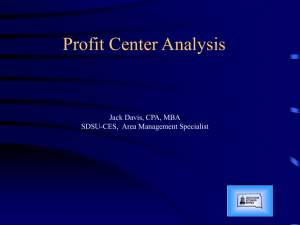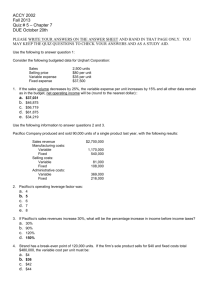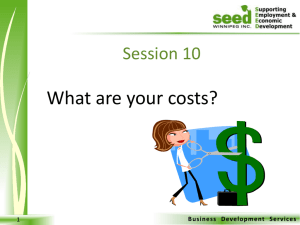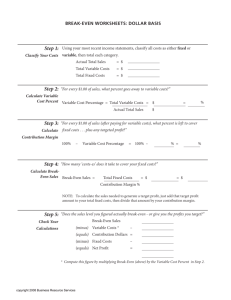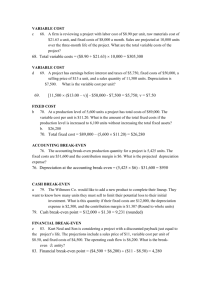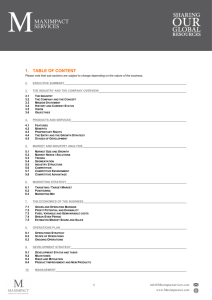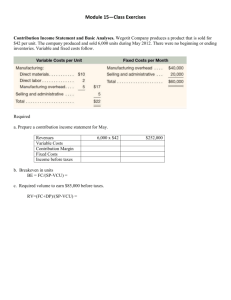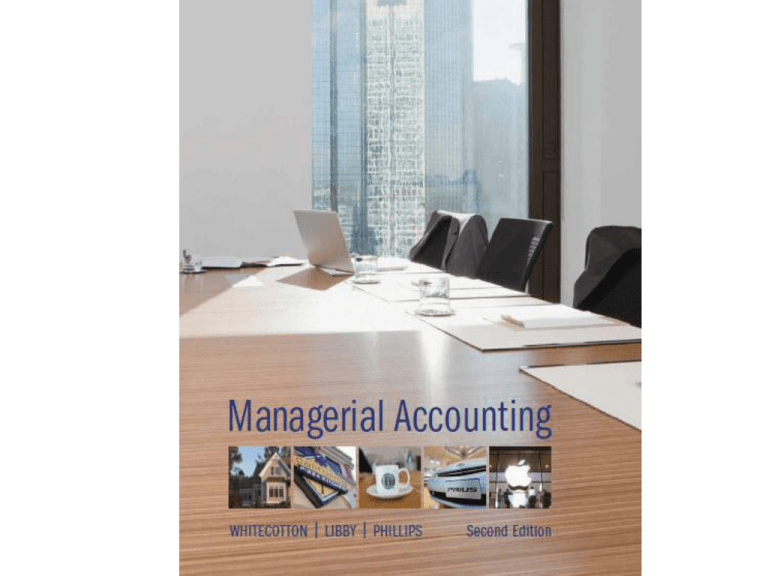
Chapter 6
Cost-Volume-Profit Analysis
PowerPoint Authors:
Susan Coomer Galbreath, Ph.D., CPA
Charles W. Caldwell, D.B.A., CMA
Jon A. Booker, Ph.D., CPA, CIA
Cynthia J. Rooney, Ph.D., CPA
McGraw-Hill/Irwin
Copyright © 2014 by The McGraw-Hill Companies, Inc. All rights reserved.
Assumptions of CVP
6- 3
Cost-Volume-Profit in Graph
$80,000
$70,000
Total Revenue
Line
$60,000
$50,000
$18,000
Target
Profit
$40,000
$30,000
Total Cost
Line
Break-Even
Point
$20,000
$10,000
Loss
$-
4,000
8,000
12,000
16,000
20,000
Number of Coffee Drinks Served
24,000
28,000
6- 4
Basic CVP Analysis
Break-even analysis is a special case of the
simplest form of cost-volume-profit analysis. The
goal of break-even analysis is to determine the level
of sales (in either units or total sales dollars) needed
to break even, or earn zero profit.
Methods
1. Profit equation method
2. Unit contribution margin method
3. Contribution margin ratio method
6- 5
Profit Equation Approach
Total sales revenue – Total variable costs – Total fixed costs = Profit
(Unit price × Q) – (Unit variable costs × Q) – Total fixed costs = Profit
Q = Quantity of unit sold
6- 6
Profit Equation Approach
To find the break-even point, we simply set the profit equation
equal to zero, and solve for the quantity of units (Q).
Break-Even Analysis
(Unit Price × Q) – (Unit Variable Costs × Q) – Total Fixed Costs = Profit
($2.50 ×Q) – ($1.00 × Q) – $12,000 = 0
$1.50Q = $12,000
Q = $12,000 ÷ $1.50
Q = 8,000
6- 7
Profit Equation Approach
Assume that the target profit was $18,000.
Target Profit Analysis
(Unit Price × Q) – (Unit Variable Costs × Q) – Total Fixed Costs = Profit
($2.50 × Q) – ($1.00 × Q) – $12,000 = $18,000
1.5Q = $30,000
Q = 20,000 units
6- 8
Unit Contribution Margin Approach
Compute the breakeven point in units for Starbucks.
Recall that Starbucks’s total fixed costs are $12,000
and the unit contribution margin is $1.50 per cup.
Break-Even
=
Units
Break-Even Units
Break-Even Units
Total Fixed Costs
Unit Contribution Margin
= $12,000 ÷ $1.50 per cup
= 8,000 cups
6- 9
Contribution Margin Ratio Approach
6- 10
Contribution Margin Ratio Approach
At break-even, the total contribution margin must equal total
fixed costs, with nothing left over as profit.
$12,000 ÷ 60% = Break-Even Sales ($)
$20,000 = Break-Even Sales ($)
6- 11
Changes in Cost Structure
Cost structure refers to how a company uses variable
costs versus fixed costs to perform its operations.
•
•
•
•
Starbucks Example:
Investing in touch screens to allow customers
to place their own order.
Increase fixed costs by $14,000 per
month.
Decrease variable costs per unit by $0.70.
Unit sales price will be unchanged at $2.50.
What level of volume would be needed to
justify this expenditure?
6- 12
Changes in Cost Structure
Before Automation
Automation increases the breakeven point because fixed costs
are higher. But each unit adds
more profit because of the lower
variable cost per unit.
After Automation
6- 13
Degree of Operating Leverage
Degree of operating leverage measures the extent to
fixed costs are used to operate the business.
In general, high fixed costs indicate that a company is
highly leveraged.
6- 14
Multi-Product Cost-Volume-Profit
Analysis
•
Product mix is the relative mix of products or
services stated in terms of the number of units
sold.
The product mix is used to compute the weightedaverage contribution margin per unit.
•
Sales mix is the relative mix of products or
services as a percentage of total sales revenue.
The sales mix is used to compute the weightedaverage contribution margin ratio, or contribution
margin as a percentage of sales.
6- 15
End of Chapter 6
6- 16


